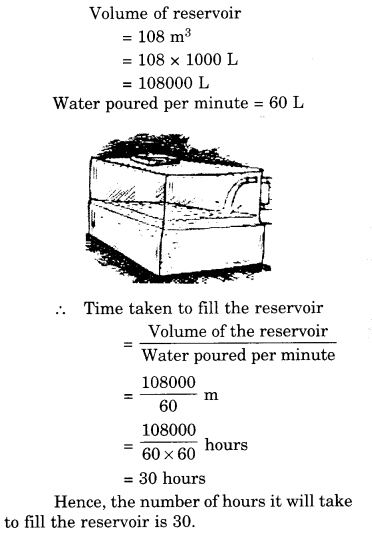Question 1.
A square and a rectangular field with measurements as given in the figure have the same perimeter. Which field has a larger area?
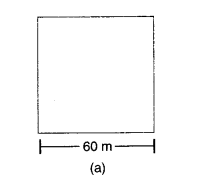
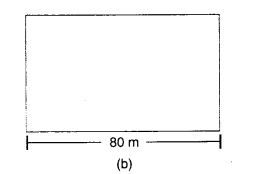
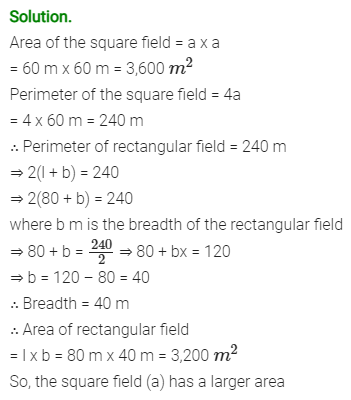
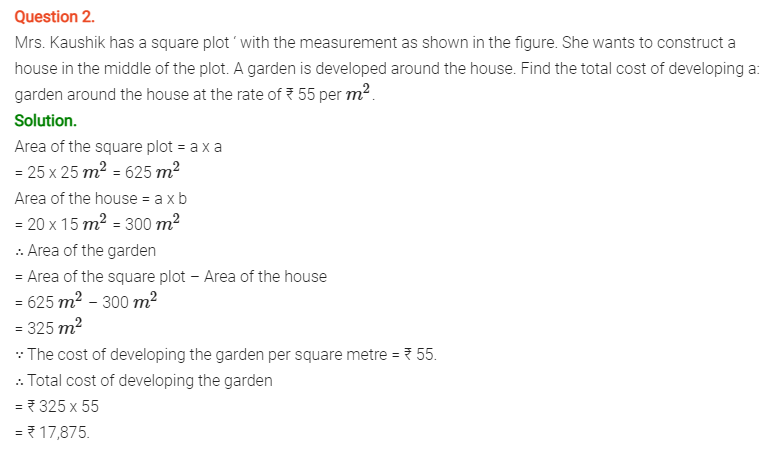
Question 3.
The shape of a garden is rectangular in the middle and semicircular at the ends as shown in the diagram. Find the area and the perimeter of this garden.
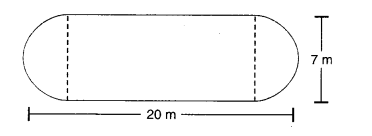
Solution
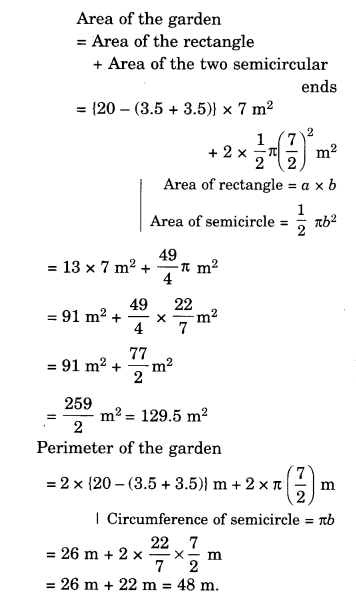
Question 4.
A flooring tile has the shape of a parallelogram whose base is 24 cm and the cor-responding height is 10 cm. How many such tiles are required to cover a floor of area 1080 m2? (If required you can split the tiles in whatever way you want to fill up the corners).
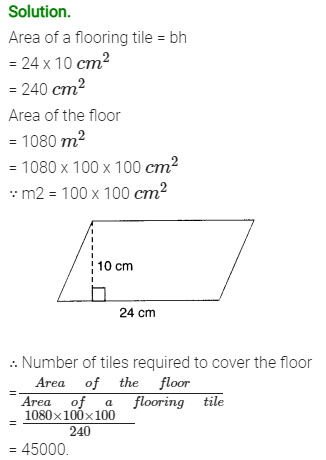
Question 5.
An ant is moving around a few food pieces of different shapes scattered on the floor. For which food-piece would the ant have to take a longer round? Remember, the circumference of a circle can be obtained by using the expression c = 2πr, where r is the radius of the circle.
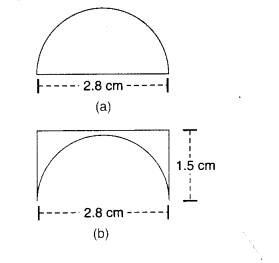
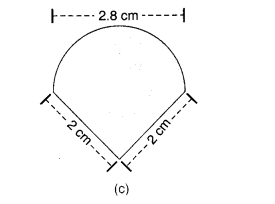
Solution
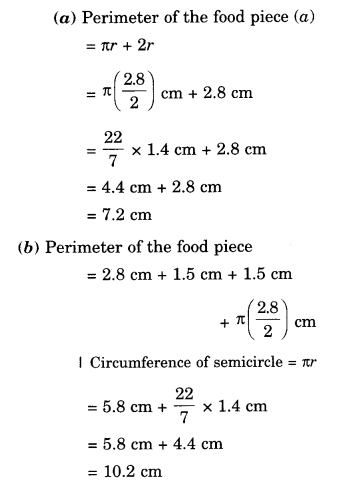
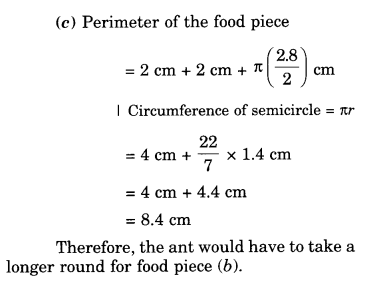
Question 1.
The shape of the top surface of a table is a trapezium. Find its area, if its parallel sides are 1 m and 1.2 man the d perpendicular distance between them is 0.8 m.
Solution.
Area of the top surface of the table
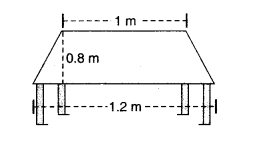
Question 2.
The area of a trapezium is 34 cm2 and the length of one of the parallel sides is 10 cm and its height is 4 cm. Find the length of the another parallel side.
Solution.
Area of trapezium
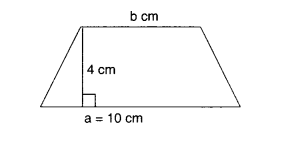
Hence, the length of another parallel side is 7 cm.
Question 3.
Length of the fence of a trapezium shaped field ABCD is 120 m. If BC = 48 m, CD = 17 m and AD = 40 m, find the area of this field. Side AB is perpendicular to the parallel sides AD and BC
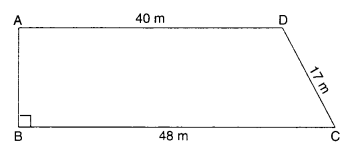
Solution.
Fence of the trapezium shaped field ABCD = 120 m
⇒ AB + BC + CD + DA = 120
⇒ AB + 48 + 17 + 40 = 120
⇒ AB + 105 = 120
⇒ AB = 120 – 105
⇒ AB = 15 m
∴ Area of the field
= (BC+AD)×AB/2
= (48+40)×16/2 = 660 m2
Question 4.
The diagonal of a quadrilateral shaped field is 24 m and the perpendiculars dropped on it from the remaining opposite vertices are 8 m and 13 m. Find the area of the field.
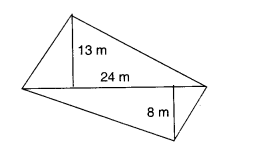
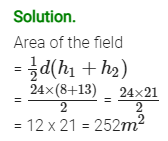
Question 5.
The diagonals of a rhombus are 7.5 cm and 12 cm. Find its area.
Solution.
Area of the rhombus
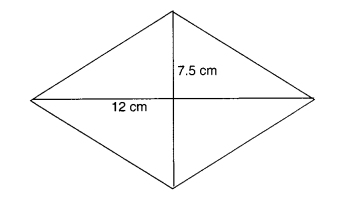
= 1/2×d1×d2
= 1/2×7.5×12
= 45 m2
Question 6.
Find the area of a rhombus whose side is 5 cm and whose altitude is 4.8 cm. If one of its diagonals is 8 cm long, find the length of the other diagonal.
Solution.
Area of the rhombus
= base (b) x altitude (h) = 5
= 5 x 4.8 = 24 cm2
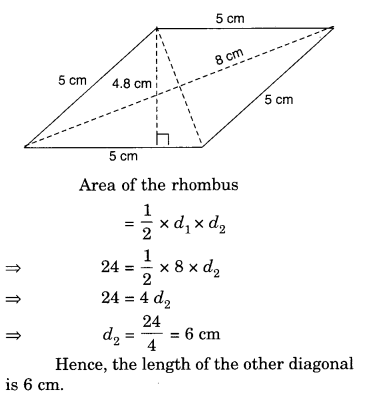
Question 7.
The floor of a building consists of 3,000 tiles which are rhombus shaped and each of its diagonals are 45 cm and 30 cm in length. Find the total cost of polishing the floor, if the cost per m2 is ? 4.
Solution.
Area of a tile
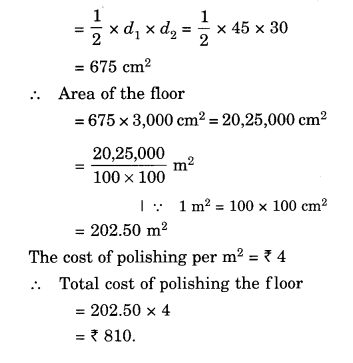
Question 8.
Mohan wants to buy a trapezium shaped field. Its side along the river is parallel to and twice the side along the road. If the area of this field is 10,500 m2 and the perpendicular distance between the two parallel sides is 100 m, find the length of the side along the river.
Solution.
Let the length of the side along the road be x m. Then, the length of the side along the river is 2x m.
Area of the field = 10,500 square metres
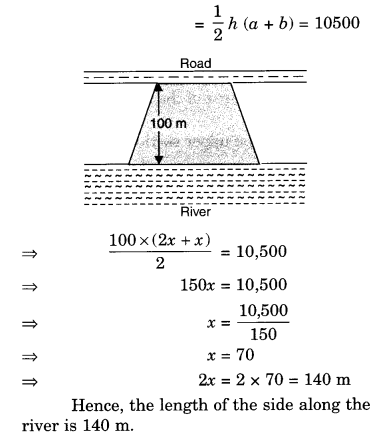
Question 9.
Top surface of a raised platform is in the shape of a regular octagon as shown in the figure. Find the area of the octagonal surface.
Solution.
Area of the octagonal surface
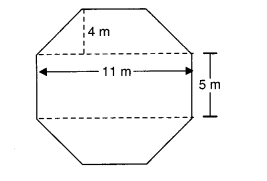
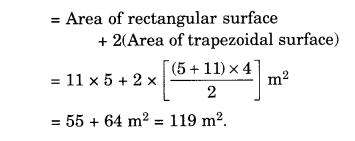
Question 10.
There is a pentagonal shaped park as shown in the figure. For finding its area Jyoti and Kavita divided it in two different ways.
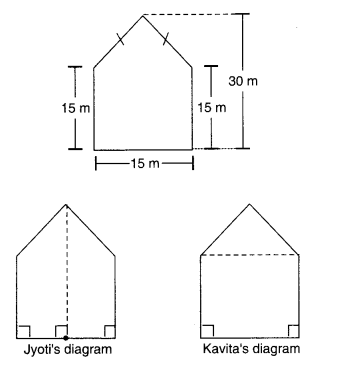
Find the area of this park using both ways. Can you suggest some other way of finding its area ?
Solution
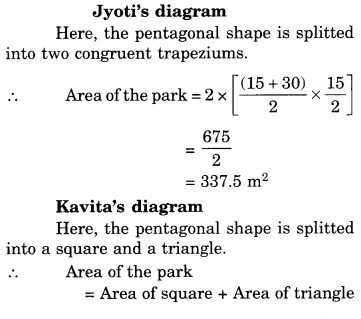
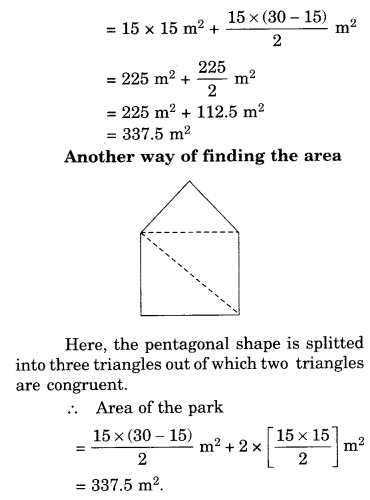
Question 11.
Diagram of the adjacent picture frame has outer dimensions = 24 cm x 28 cm and inner dimensions 16 cm x 20 cm. Find the area of each section of the frame, if the width of each section the same.

Solution
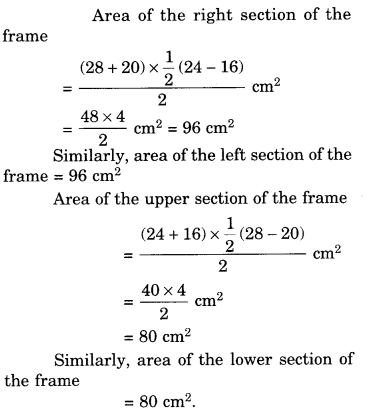
Question 1.
There are two cuboidal boxes as shown in the adjoining figure. Which box requires the lesser amount of material to make?
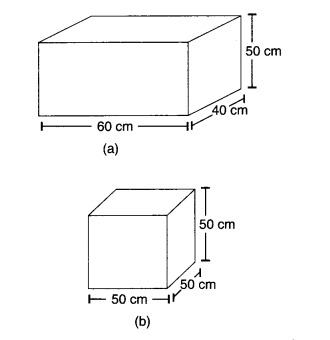
Solution
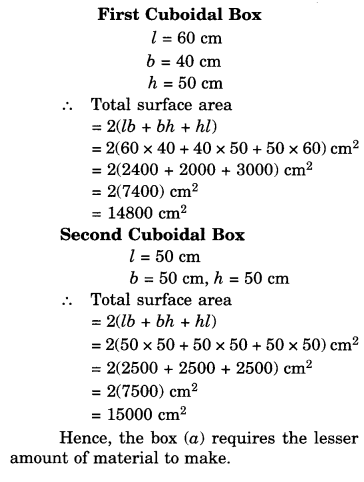
Question 2.
A suitcase with measures 80 cm x 48 cm x 24 cm is to be covered with a tarpau¬lin cloth. How many meters of tarpaulin of width 96 cm is required to cover 100 such suitcases?
Solution.
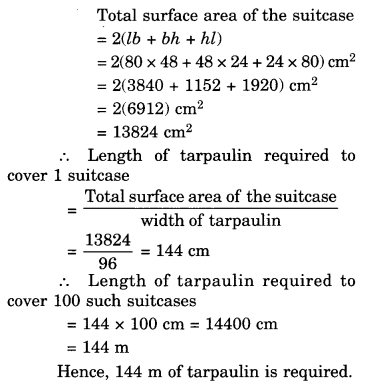
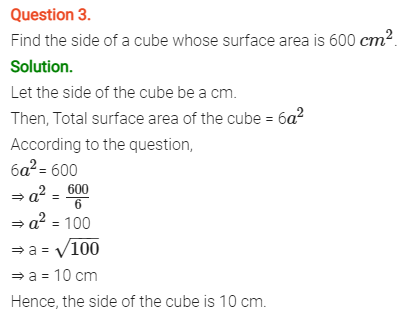
Question 4.
Rukhsar painted the outside of the cabinet of measure 1 m x 2 m x 1.5 m. How much surface area did she cover if she painted all except the bottom of the cabinet?
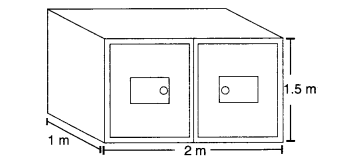
Solution
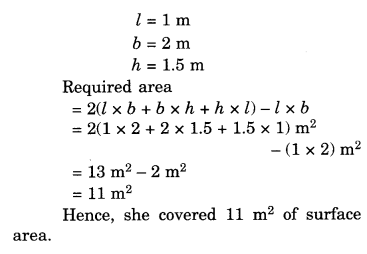
Question 5.
Daniel is painting the walls and ceiling of a cuboidal hall with length, breadth, and height of 15 m, 10 m and 7 m respectively. From each can of paint 100 m2 of area is painted.
How many cans of paint will she need to paint the room?
Solution.
l = 15 m
b = 10 m
h = 7 m
Surface area to be painted
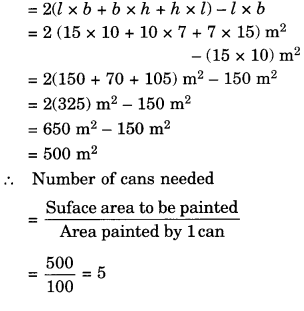
Hence, she will need 5 cans of paint to paint the room.
Question 6.
Describe how the two figures at the right are alike and how they are different. Which box has a larger lateral surface area?
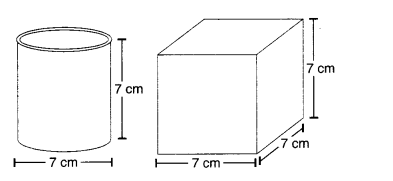
Solution.
Similarity → Both have the same heights.
Difference → One is a cylinder, the other is a cube;
The cylinder is a solid obtained by revolving a rectangular area about its one side whereas a cube is a solid enclosed by six square faces; a cylinder has two circular faces whereas a cube has six square faces.
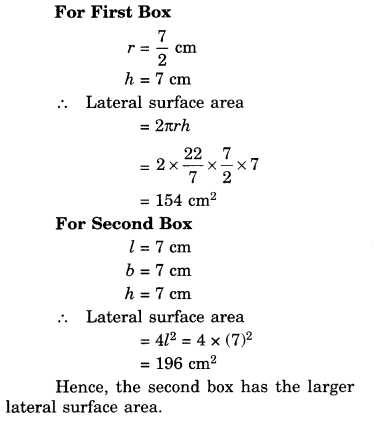
Question 7.
A closed cylindrical tank of radius 7 m and height 3 m is made from a sheet of metal. How many sheets of metal is required?
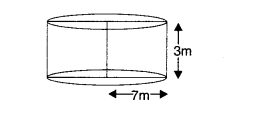
Solution
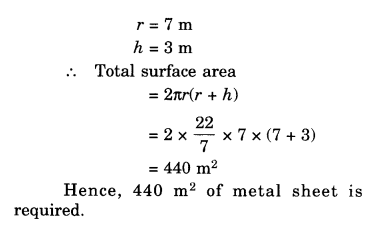
Question 8.
The lateral surface area of a hollow cylinder is 4224 cm2. It is cut along its height and formed a rectangular sheet of width 33 cm. Find the perimeter of rectangular sheet?
Solution.
Lateral surface area of the hollow cylinder = 4224 cm2
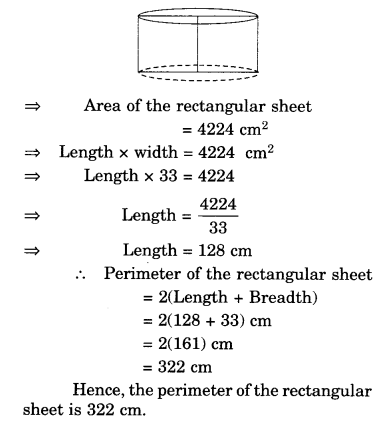
Question 9.
A road roller takes 750 complete revolutions to move once over to level a road. Find the area of the road if the diameter of a road roller is 84 cm and length is 1 m.
Solution.
Diameter of the road roller = 84 cm
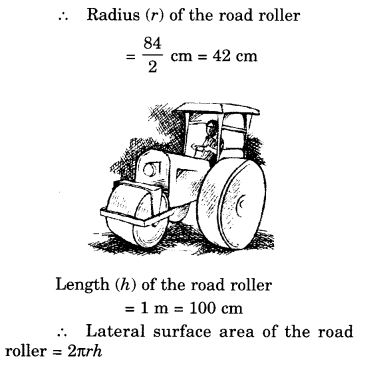

Question 10.
A company packages its milk powder in the cylindrical container whose base has a diameter of 14 cm and height 20 cm. The company places a label around the surface of the container (as shown in the figure). If the label is placed 2 cm from top and bottom, what is the area of the label?
Solution.
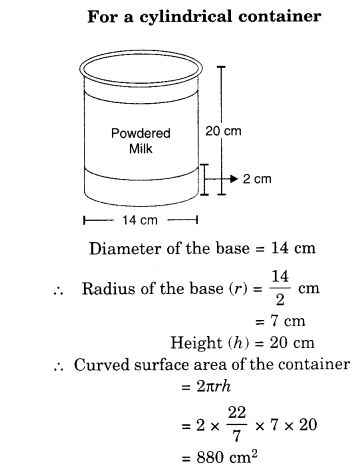
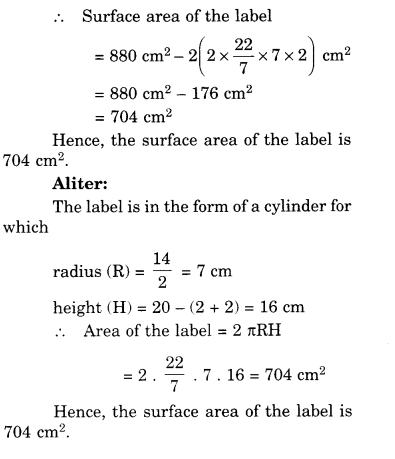
Question 1.
Given a cylindrical tank, in which situation will you find the surface area and in which situation volume?
- (a) To find how much it can hold.
- (b) Number of cement bags required to plaster it.
- (c) To find the number of smaller tanks that can be filled with water from it.
Solution.
- (a) Volume
- (b) Surface area
- (c) Volume.
Question 2.
The diameter of cylinder A is 7 cm, and the height is 14 cm. The diameter of cylinder B is 14 cm and height is 7 cm. Without doing any calculations can you suggest whose volume is greater? Verify it by finding the volume of both the cylinders. Check whether the cylinder with greater volume also has a greater surface area?
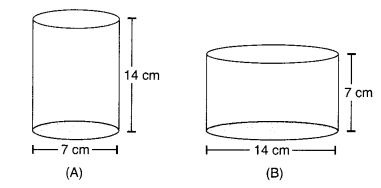
Solution
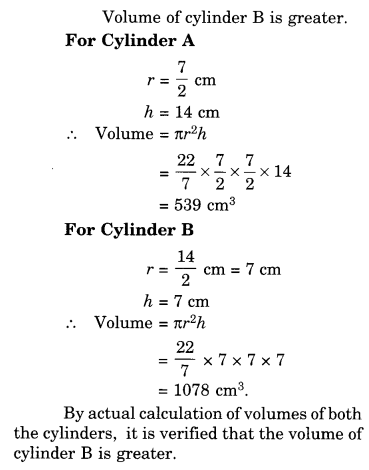
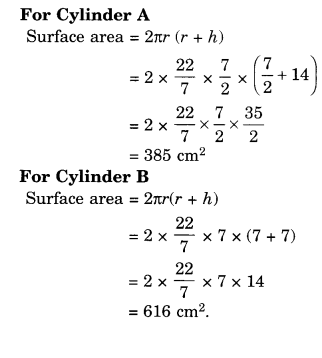


Question 4.
A cuboid is of dimensions 60 cm x 54 cm x 30 cm. How many small cubes with side 6 cm can be placed in the given cuboid?
Solution.
A volume of the cuboid
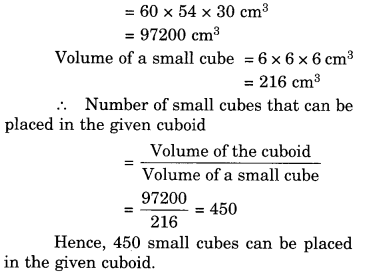
Question 5.
Find the height of the cylinder whose volume is 1.54 m3 and diameter of the base is 140 cm.
Solution.
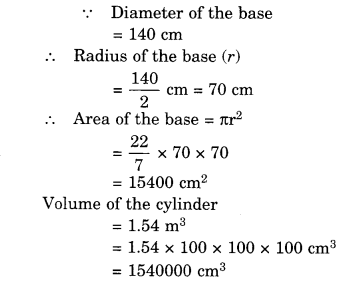
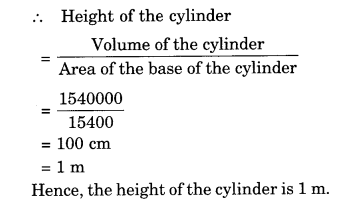
Question 6.
A milk tank is in the form of a cylinder whose radius is 1.5 m and length is 7 m. Find the quantity of milk in liters that can be stored in the tank.
Solution.
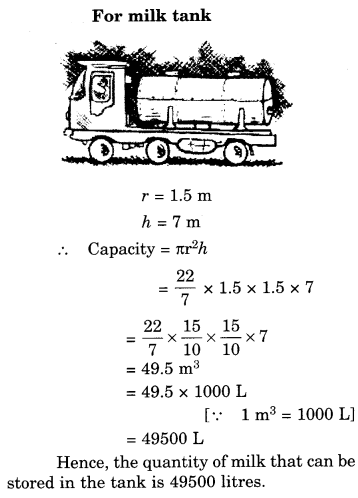
Question 7.
If each edge of a cube is doubled,
- (i) how many times will its surface area increase?
- (ii) how many times will its volume increase?
Solution.
Let the original edge of the cube be a cm.
Then, its new edge = 2a cm
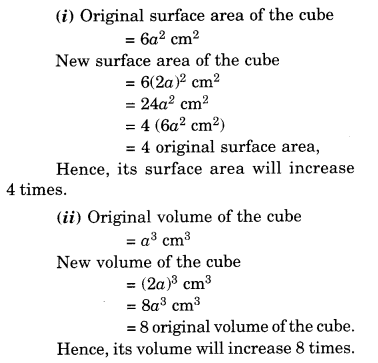
Question 8.
Water is pouring into a cuboidal reservoir at the rate of 60 liters per minute. If the volume of the reservoir is 108 m3, find the number of hours it will take to fill the reservoir.
Solution.
